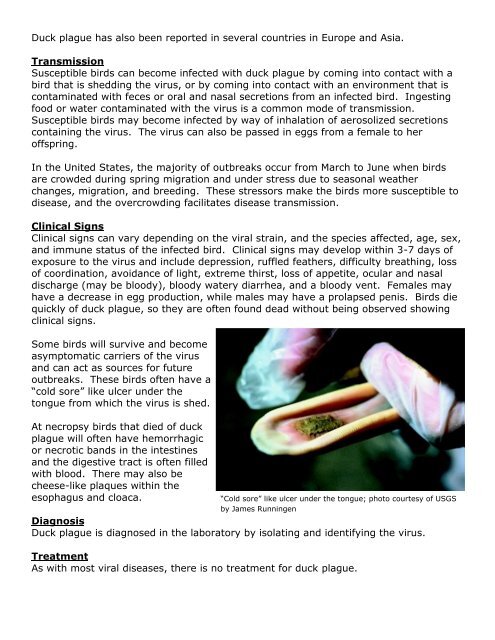Duck Plague
Duck Plague
Duck Plague
You also want an ePaper? Increase the reach of your titles
YUMPU automatically turns print PDFs into web optimized ePapers that Google loves.
<strong>Duck</strong> plague has also been reported in several countries in Europe and Asia.<br />
Transmission<br />
Susceptible birds can become infected with duck plague by coming into contact with a<br />
bird that is shedding the virus, or by coming into contact with an environment that is<br />
contaminated with feces or oral and nasal secretions from an infected bird. Ingesting<br />
food or water contaminated with the virus is a common mode of transmission.<br />
Susceptible birds may become infected by way of inhalation of aerosolized secretions<br />
containing the virus. The virus can also be passed in eggs from a female to her<br />
offspring.<br />
In the United States, the majority of outbreaks occur from March to June when birds<br />
are crowded during spring migration and under stress due to seasonal weather<br />
changes, migration, and breeding. These stressors make the birds more susceptible to<br />
disease, and the overcrowding facilitates disease transmission.<br />
Clinical Signs<br />
Clinical signs can vary depending on the viral strain, and the species affected, age, sex,<br />
and immune status of the infected bird. Clinical signs may develop within 3-7 days of<br />
exposure to the virus and include depression, ruffled feathers, difficulty breathing, loss<br />
of coordination, avoidance of light, extreme thirst, loss of appetite, ocular and nasal<br />
discharge (may be bloody), bloody watery diarrhea, and a bloody vent. Females may<br />
have a decrease in egg production, while males may have a prolapsed penis. Birds die<br />
quickly of duck plague, so they are often found dead without being observed showing<br />
clinical signs.<br />
Some birds will survive and become<br />
asymptomatic carriers of the virus<br />
and can act as sources for future<br />
outbreaks. These birds often have a<br />
“cold sore” like ulcer under the<br />
tongue from which the virus is shed.<br />
At necropsy birds that died of duck<br />
plague will often have hemorrhagic<br />
or necrotic bands in the intestines<br />
and the digestive tract is often filled<br />
with blood. There may also be<br />
cheese-like plaques within the<br />
esophagus and cloaca.<br />
“Cold sore” like ulcer under the tongue; photo courtesy of USGS<br />
by James Runningen<br />
Diagnosis<br />
<strong>Duck</strong> plague is diagnosed in the laboratory by isolating and identifying the virus.<br />
Treatment<br />
As with most viral diseases, there is no treatment for duck plague.


